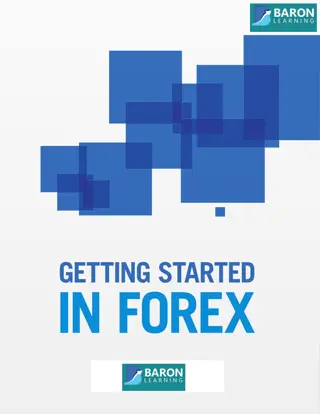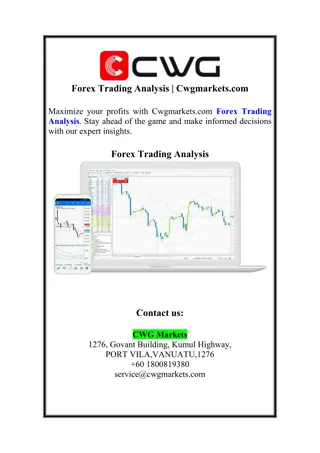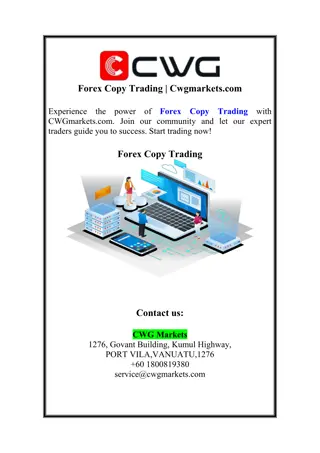Understanding Forex Trading: A Comprehensive Overview
The Foreign Exchange (Forex) market is a decentralized global marketplace where various currencies are traded by a wide range of participants. Learn about the basics of Forex trading, its liquidity, trading hours, oversight, currency pairs, exchange rates, pips, and more from this informative content.
Download Presentation

Please find below an Image/Link to download the presentation.
The content on the website is provided AS IS for your information and personal use only. It may not be sold, licensed, or shared on other websites without obtaining consent from the author. Download presentation by click this link. If you encounter any issues during the download, it is possible that the publisher has removed the file from their server.
E N D
Presentation Transcript
What is Forex? Foreign Exchange Forex Market FX Currency Trading A decentralized global market where all the world's currencies trade Traders consist of banks, businesses, governments, investors and retail traders (like me) who speculate on currencies.
Introduction Freddy Martinez Systems Programmer @ ECISD Forex Technical Analyst by night Financial goal: Make money out of money
Trading hours? The Fx market is open 24 hours a day, 5 days a week with the most important world trading centers being located in London, New York, Tokyo, Zurich, Frankfurt, Hong Kong, Singapore, Paris, and Sydney.
What is Forex? Most liquid market with an average daily trading volume of +$5 Trillion Not even all stock markets combined come close
Oversight? There is no central marketplace Trading is conducted over the counter It s not like stocks where there is a central marketplace with all orders processed like the NYSE Forex is a product quoted by all the major banks, and not all banks will have the exact same price
What is Forex Trading? Forex trading is the speculation on the price of one currency against another. For example, if you think the euro is going to rise against the U.S. dollar, you can buy the EURUSD currency pair low and then (hopefully) sell it at a higher price to make a profit. Of course, if you buy the euro against the dollar (EURUSD), and the U.S. dollar strengthens, you will then be in a losing position. Or imagine exchanging $100 USD into pesos and then the peso's value increases. Exchanging back to USD will net you more than $100 because the peso was worth more than when you bought it.
Exchange Rate The value of one currency expressed in terms of another. For example, if EUR/USD is 1.3200, 1 Euro is worth US$1.3200.
Pip The smallest increment of price movement a currency can make. Also called point or points. For example, 1 pip for the EUR/USD = 0.0001 and 1 pip for the USD/JPY = 0.01.
Leverage Leverage is the ability to gear your account into a position greater than your total account margin. For instance, if a trader has $1,000 of margin in his account and he opens a $100,000 position, he leverages his account by 100 times, or 100:1. If he opens a $200,000 position with $1,000 of margin in his account, his leverage is 200 times, or 200:1. Increasing your leverage magnifies both gains and losses.
Currency Pairs The exchange rate of two currencies is quoted in a pair, such as the EURUSD or the USDJPY. The reason for this is because in any foreign exchange transaction you are simultaneously buying one currency and selling another. I f you were to buy the EURUSD and the euro strengthened against the dollar, you would then be in a profitable trade.
Bid and Ask Price Bid Price The bid is the price at which the market (or your broker) will buy a specific currency pair from you. Thus, at the bid price, a trader can sell the base currency to their broker. Ask Price The ask price is the price at which the market (or your broker) will sell a specific currency pair to you. Thus, at the ask price you can buy the base currency from your broker.
Long Buying LONG When we go long it means we are buying the market and so we want the market to rise so that we can then sell back our position at a higher price than we bought for. This means we are buying the first currency in the pair and selling the second. So, if we buy the EURUSD and the euro strengthens relative to the U.S. dollar, we will make money!
Short Selling SHORT When we go short it means we are selling the market and so we want the market to fall so that we can then buy back our position at a lower price than we sold it for. This means we are selling the first currency in the pair and buying the second. So, if we sell the GBPUSD and the British pound weakens relative to the U.S. dollar, we will be in a profitable trade.
Technical Analysis RSI MACD Stochastics Volume Moving Averages Bollinger Bands Multi-time frame analysis Price Action Divergence


![Guardians of Collection Enhancing Your Trading Card Experience with the Explorer Sleeve Bundle [4-pack]](/thumb/3698/guardians-of-collection-enhancing-your-trading-card-experience-with-the-explorer-sleeve-bundle-4-pack.jpg)




















